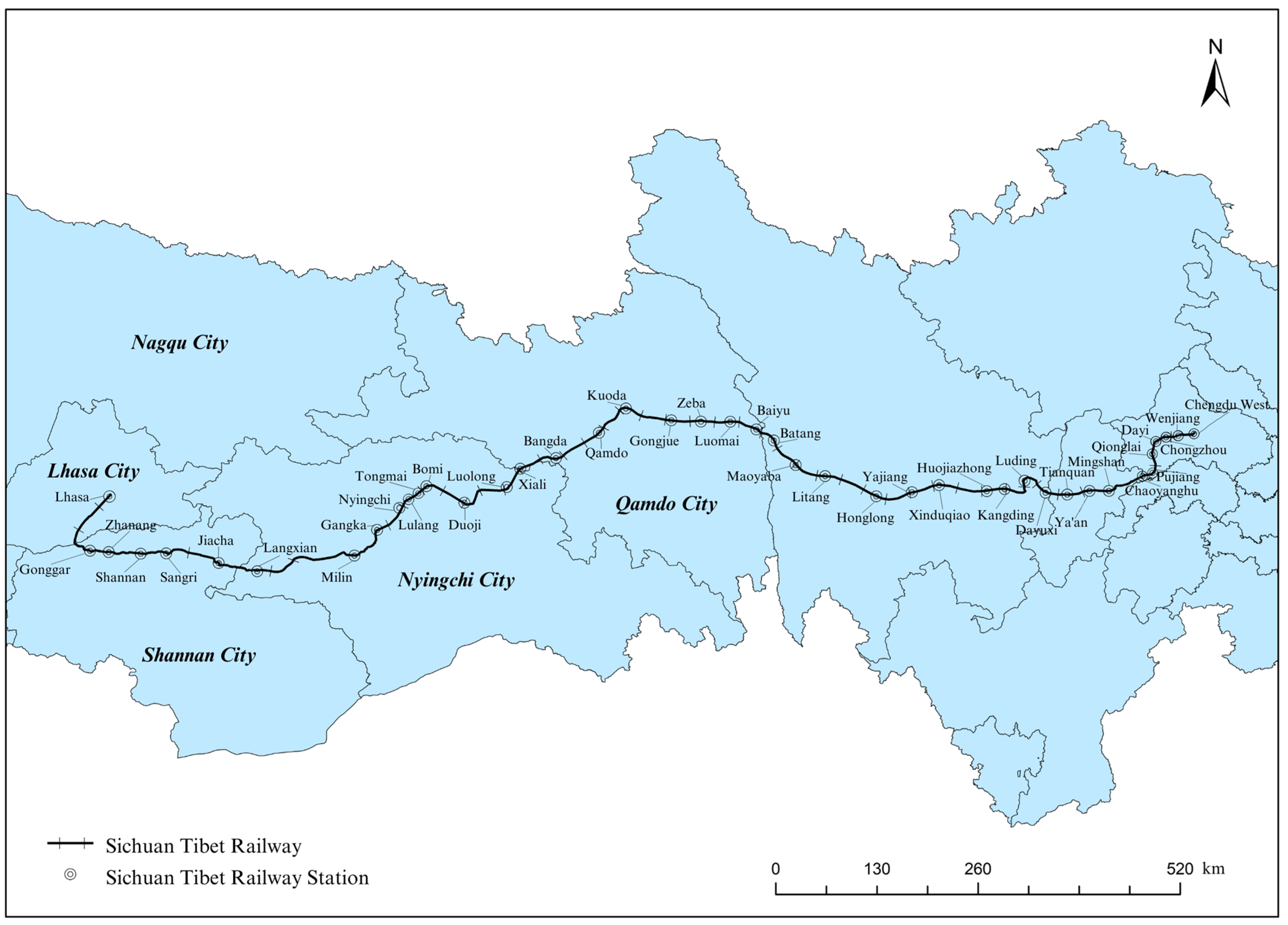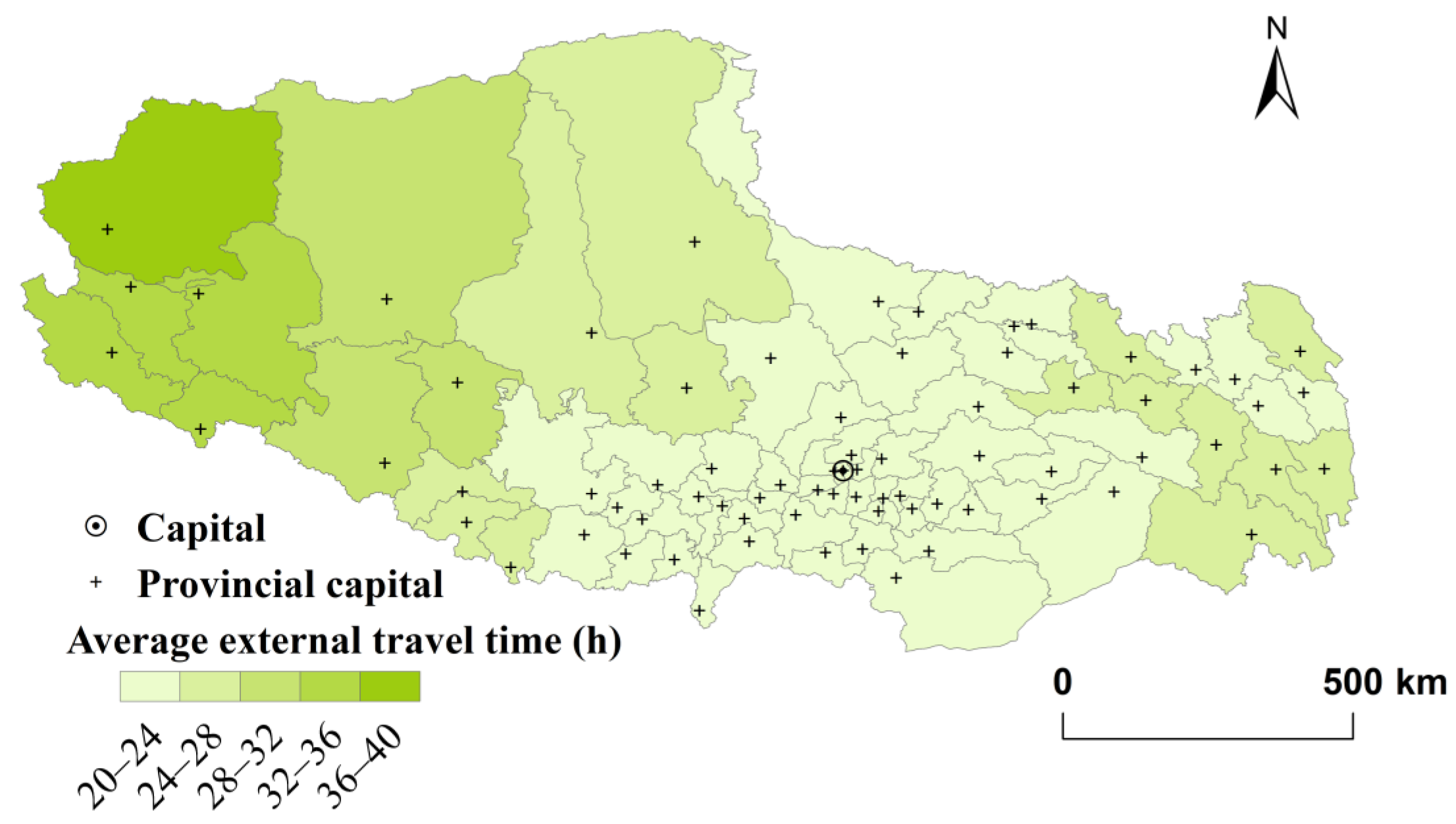How Much Will the Sichuan–Tibet Railway Improve the Accessibility of Tibet, China: A Comparative Study by Multiple Scenarios
Abstract
1. Introduction
2. Study Area and Data
2.1. Study Area
2.2. Data
3. Study Methods
3.1. Research Scenario Setting
3.2. Accessibility Measurement
3.2.1. Shortest Travel Time
3.2.2. Weighted Average Travel Time
3.2.3. External Average Travel Time
3.2.4. Coefficient of Variation
4. Results
4.1. Internal Traffic Accessibility and Changes
4.2. External Traffic Accessibility and Changes
4.3. Equity Analysis
5. Discussion
6. Conclusions
- (1)
- The internal and external transportation accessibility of all counties in Tibet has significantly improved after the opening of the Sichuan–Tibet Railway, with a notable space-time convergence effect. Once the railway is fully operational, the average reduction in internal accessibility travel time for each county is 4 h, while the average reduction in external accessibility travel time is 22 h, effectively shortening both intra-provincial and inter-provincial travel times.
- (2)
- The spatial pattern of accessibility in Tibet has limited changes before and after the Sichuan–Tibet Railway’s operation. The areas with the highest accessibility remain in the intersecting regions of the Qinghai–Tibet and Sichuan–Tibet Railways. The overall spatial pattern shows Lhasa, Nyingchi, Shigatse, and Nagqu as the core areas, radiating outwards to surrounding regions.
- (3)
- The degree of accessibility optimization brought by the Sichuan–Tibet Railway varies across different regions. In terms of internal accessibility, the regions along the Sichuan–Tibet Railway and the intersecting areas with the Qinghai–Tibet Railway experienced a change rate of 50–80%, showing a more significant improvement in accessibility. This demonstrates a clear transportation corridor-oriented pattern. In terms of external accessibility, the areas with the greatest improvement are the peripheral regions that had low accessibility levels and poor connectivity before the railway’s opening. This indicates that the operation of the Sichuan–Tibet Railway also exerts a significant spillover effect on improving the accessibility of areas surrounding the railway, significantly enhancing the convenience of connections between peripheral and central cities.
Author Contributions
Funding
Institutional Review Board Statement
Informed Consent Statement
Data Availability Statement
Acknowledgments
Conflicts of Interest
References
- Wang, J.; Ding, J. High-speed Rail and Its impacts on the Urban Spatial Structure of China. Urban Plan. Int. 2011, 26, 49–54. (In Chinese) [Google Scholar]
- Jin, F.; Jiao, J.; Qi, Y.; Yang, Y. Evolution and geographic effects of high-speed rail in East Asia: An accessibility approach. J. Geogr. Sci. 2017, 27, 515–532. [Google Scholar] [CrossRef]
- Zhong, Y.; Huang, J.; Wen, Y. Impact of High-speed Railway on Spatial Pattern of Chinese Cities’ Accessibility. Sci. Geogr. Sin. 2015, 35, 387–395. (In Chinese) [Google Scholar]
- Jiao, J.; Wang, J.; Jin, F.; Dunford, M. Impacts on accessibility of China’s present and future HSR network. J. Transp. Geogr. 2014, 40, 123–132. [Google Scholar] [CrossRef]
- Martínez Sánchez-Mateos, H.S.; Givoni, M. The accessibility impact of a new High-Speed Rail line in the UK—A preliminary analysis of winners and losers. J. Transp. Geogr. 2012, 25, 105–114. [Google Scholar] [CrossRef]
- Gao, X.; Wang, B.; Sun, D. Do railways improve territorial cohesion of the Tibetan Plateau? A case study of the Qinghai-Tibet Railway. Appl. Geogr. 2022, 144, 102720. [Google Scholar] [CrossRef]
- Pyrialakou, V.D.; Gkritza, K.; Fricker, J.D. Accessibility, mobility, and realized travel behavior: Assessing transport disadvantage from a policy perspective. J. Transp. Geogr. 2016, 51, 252–269. [Google Scholar] [CrossRef]
- Hou, Q.; Li, S. Transport infrastructure development and changing spatial accessibility in the Greater Pearl River Delta, China, 1990–2020. J. Transp. Geogr. 2011, 19, 1350–1360. [Google Scholar] [CrossRef]
- Xu, W.; Zhou, J.; Yang, L.; Li, L. The implications of high-speed rail for Chinese cities: Connectivity and accessibility. Transport. Res. A-Pol. 2018, 116, 308–326. [Google Scholar]
- Hansen, W.G. How Accessibility Shapes Land Use. J. Am. Plann. Assoc. 1959, 25, 73–76. [Google Scholar] [CrossRef]
- Liang, Y.; Zhou, K.; Lin, X.; Zhou, Z.; Sun, W.; Zeng, J. Effectiveness of high-speed railway on regional economic growth for less developed areas. J. Transp. Geogr. 2020, 82, 02621. [Google Scholar] [CrossRef]
- Cui, J.; Li, X.; Chu, N. Coordination research of high-speed rail accessibility and economic-social development level in less developed areas. Econ. Geogr. 2020, 40, 43–51. (In Chinese) [Google Scholar]
- Wu, L.; Song, X.; Yin, F. Impact of high-speed railway network on county-level accessibility and economic linkage in Jiangxi Province, China: A spatio-temporal data analysis. Open Geosci. 2024, 16, 20220678. [Google Scholar] [CrossRef]
- Zhou, R.; Yu, Y.; Wang, Z.; Dong, L.; Luo, X. The spatially differentiated impact of high-speed railway on accessibility and socio-economic development of developing regions: A study in southwest China. Socio-Econ. Plann. Sci. 2024, 95, 102037. [Google Scholar] [CrossRef]
- Yu, N.; Jin, Y. The unintended economic impact of high-speed rail on China’s non-core cities: A spatial-difference-in-differences analysis. Cities 2023, 143, 104618. [Google Scholar] [CrossRef]
- Yang, X.; Qiu, X.; Fang, Y.; Xu, Y.; Zhu, F. Spatial variation of the relationship between transport accessibility and the level of economic development in Qinghai-Tibet Plateau, China. J. Mt. Sci. 2019, 16, 1883–1900. [Google Scholar] [CrossRef]
- Gong, Q.; Li, J.; Wu, L.; Zhu, M.; Luo, M.; Sun, J.; Fu, W.; Ma, R.; Liang, X. Exploring Accessibility and Its Impact in the Mountain City: A Typical Case Study of Nyingchi City, Tibet Autonomous Region, China. Land 2023, 12, 361. [Google Scholar] [CrossRef]
- Gao, X.; Li, T.; Cao, X. Spatial Fairness and Changes in Transport Infrastructure in the Qinghai-Tibet Plateau Area from 1976 to 2016. Sustainability 2019, 11, 589. [Google Scholar] [CrossRef]
- Gao, D.; Li, S. Spatiotemporal impact of railway network in the Qinghai-Tibet Plateau on accessibility and economic linkages during 1984–2030. J. Transp. Geogr. 2022, 100, 103332. [Google Scholar] [CrossRef]
- Miao, Y.; Lu, W.; Dai, T.; Song, J. Comprehensive traffic advantage degree and its spatial characteristics at the prefecture level on the Qinghai-Tibet Plateau: A case study of Linzhi City. Prog. Geogr. 2021, 40, 1332–1343. (In Chinese) [Google Scholar] [CrossRef]
- Yu, T.; Yan, J.; Wu, Y. Study on Time-space Compression Effect Pattern of County Traffic Accessibility in Tibet. Areal Res. Dev. 2022, 41, 26–30+43. (In Chinese) [Google Scholar]
- Liu, Q.; Lu, W.; Dai, T.; Song, J.; Liu, Y.; Li, J. Evaluation of road accessibility in the Qinghai-Tibet Plateau region considering seasonality. Prog. Geogr. 2023, 42, 687–700. (In Chinese) [Google Scholar] [CrossRef]
- Dai, T.; Guo, K.; Wu, J.; Zhang, L. Accessibility improvement and landscape ecological effect of highway development in Tibet. Prog. Geogr. 2023, 42, 1882–1890. (In Chinese) [Google Scholar] [CrossRef]
- Li, S.; Gong, J.; Deng, Q.; Zhou, T. Impacts of the Qinghai-Tibet Railway on Accessibility and Economic Linkage of the Third Pole. Sustainability 2018, 10, 3982. [Google Scholar] [CrossRef]
- Jiang, H.; Zhang, W.; Qi, Y.; Liang, Z. Research progress on accessibility to regional transportation infrastructure. Prog. Geogr. 2013, 32, 807–817. (In Chinese) [Google Scholar]
- Wang, J.; Du, D. Building Strong Transportation Network for Serving Chinese-style Modernization: Connotation Analysis and Discipline Development. Econ. Geogr. 2023, 43, 6–14. (In Chinese) [Google Scholar]
- Huang, J.; Xiong, M.; Wang, J.; Gao, Y.; Li, Y. Temporal efficiency of cross-border railways with multiple simulation scenarios: A case study of the China-Laos Railway. Sci. Geogr. Sin. 2024, 44, 91–98. (In Chinese) [Google Scholar]
- Stepniak, M.; Rosik, P. Accessibility improvement, territorial cohesion and spillovers: A multidimensional evaluation of two motorway sections in Poland. J. Transp. Geogr. 2013, 31, 154–163. [Google Scholar] [CrossRef]
- Wang, D.; Wang, K.; Wang, Z.; Fan, H.; Chai, H.; Wang, H.; Long, H.; Gao, J.; Xu, J. Spatial-Temporal Evolution and Influencing Mechanism of Traffic Dominance in Qinghai-Tibet Plateau. Sustainability 2022, 14, 11031. [Google Scholar] [CrossRef]
- JTGB01-2014; Technical Standard of Highway Engineering. Chinese Standard: Beijing, China, 2014.
- Yu, M.; Fan, W. Accessibility impact of future high speed rail corridor on the piedmont Atlantic megaregion. J. Transp. Geogr. 2018, 73, 1–12. [Google Scholar] [CrossRef]
- Yang, J.; Guo, A.; Li, X.; Huang, T. Study of the Impact of a High-Speed Railway Opening on China’s Accessibility Pattern and Spatial Equality. Sustainability 2018, 10, 2943. [Google Scholar] [CrossRef]
- Luo, H.; Zhao, S. Impacts of high-speed rail on the inequality of intercity accessibility: A case study of Liaoning Province, China. J. Transp. Geogr. 2021, 90, 102920. [Google Scholar] [CrossRef]
- Huang, Y.; Zong, H. Has high-speed railway promoted spatial equity at different levels? A case study of inland mountainous area of China. Cities 2021, 110, 103076. [Google Scholar] [CrossRef]
- Cao, J.; Liu, X.; Wang, Y.; Li, Q. Accessibility impacts of China’s high-speed rail network. J. Transp. Geogr. 2013, 28, 12–21. [Google Scholar] [CrossRef]
- Wang, X.; Zhang, W. Efficiency and spatial equity impacts of high-speed rail on the central plains economic region of China. Sustainability 2019, 11, 2583. [Google Scholar] [CrossRef]
- Wang, L.; Duan, X. High-speed rail network development and winner and loser cities in megaregions: The case study of the Yangtze River Delta, China. Cities 2018, 83, 71–82. [Google Scholar] [CrossRef]
- Miao, Y.; Dai, T.; Song, J. Assessing the effects of the large-scale road construction on the ethnic disparities of accessibility in Tibet from 2010 to 2020. Growth Chang. 2023, 54, 754–770. [Google Scholar] [CrossRef]
- Miao, Y.; Dai, T.; Song, J.; Ding, T.; Lu, W. Concept expansion, method improvement of transport superiority degree and its empirical application in Tibet. Acta Geogr. Sin. 2023, 78, 1515–1529. (In Chinese) [Google Scholar]










| Scenario | Stage Characteristics | Data Composition of the Internal Transport Network | Data Composition of the External Transport Network |
|---|---|---|---|
| 1 | No opening of the Sichuan–Tibet Railway | 2020 Road Traffic Network Data + Qinghai–Tibet Railway (Tibet Section) | 2020 Road Traffic Network Data + Qinghai–Tibet Railway (Tibet Section) + Railway Connections Outside Tibet |
| 2 | Partial opening of the Sichuan–Tibet Railway (Lhasa–Nyingchi section) | 2021 Road Traffic Network Data + Qinghai–Tibet Railway (Tibet Section) + Sichuan–Tibet Railway (Lhasa-Nyingchi section) | 2021 Road Traffic Network Data + Qinghai–Tibet Railway (Tibet Section) + Sichuan–Tibet Railway (Lhasa-Nyingchi section) + Railway Connections Outside Tibet |
| 3 | Full Operation of the Sichuan–Tibet Railway | 2022 Road Traffic Network Data + Qinghai–Tibet Railway (Tibet Section) + Sichuan–Tibet Railway (Tibet Section) | 2022 Road Traffic Network Data + Qinghai–Tibet Railway (Tibet Section) + Sichuan–Tibet Railway (Tibet Section) + Railway Connections Outside Tibet |
| Before | After | |
|---|---|---|
| Coefficient of the variation in inward-weighted average travel times | 0.40 | 0.71 |
| Coefficient of the variation in average external travel times | 0.09 | 0.16 |
Disclaimer/Publisher’s Note: The statements, opinions and data contained in all publications are solely those of the individual author(s) and contributor(s) and not of MDPI and/or the editor(s). MDPI and/or the editor(s) disclaim responsibility for any injury to people or property resulting from any ideas, methods, instructions or products referred to in the content. |
© 2024 by the authors. Licensee MDPI, Basel, Switzerland. This article is an open access article distributed under the terms and conditions of the Creative Commons Attribution (CC BY) license (https://creativecommons.org/licenses/by/4.0/).
Share and Cite
Du, Y.; Tian, C.; Miao, Y. How Much Will the Sichuan–Tibet Railway Improve the Accessibility of Tibet, China: A Comparative Study by Multiple Scenarios. Sustainability 2024, 16, 10179. https://doi.org/10.3390/su162310179
Du Y, Tian C, Miao Y. How Much Will the Sichuan–Tibet Railway Improve the Accessibility of Tibet, China: A Comparative Study by Multiple Scenarios. Sustainability. 2024; 16(23):10179. https://doi.org/10.3390/su162310179
Chicago/Turabian StyleDu, Yiran, Chenrui Tian, and Yi Miao. 2024. "How Much Will the Sichuan–Tibet Railway Improve the Accessibility of Tibet, China: A Comparative Study by Multiple Scenarios" Sustainability 16, no. 23: 10179. https://doi.org/10.3390/su162310179
APA StyleDu, Y., Tian, C., & Miao, Y. (2024). How Much Will the Sichuan–Tibet Railway Improve the Accessibility of Tibet, China: A Comparative Study by Multiple Scenarios. Sustainability, 16(23), 10179. https://doi.org/10.3390/su162310179






